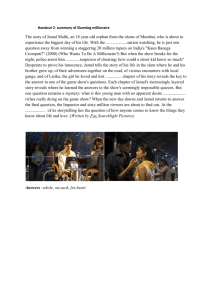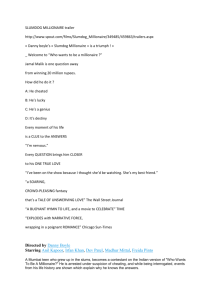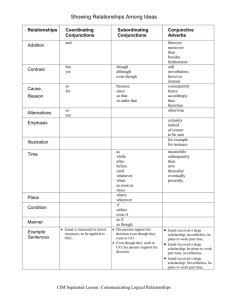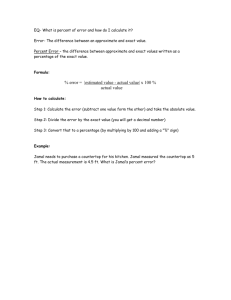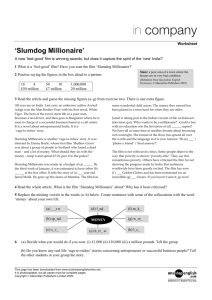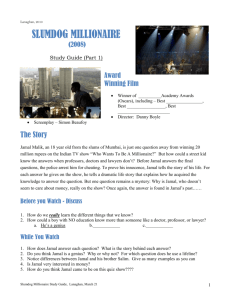Slumdog Millionaire Lesson Plan: High School ELA
advertisement
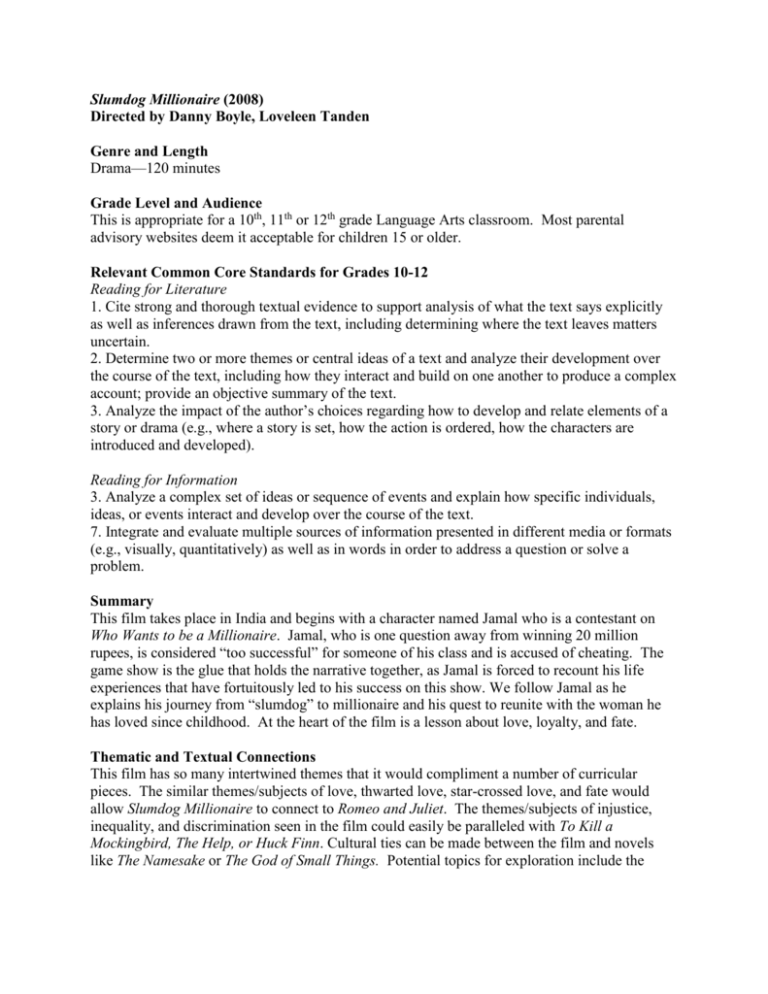
Slumdog Millionaire (2008) Directed by Danny Boyle, Loveleen Tanden Genre and Length Drama—120 minutes Grade Level and Audience This is appropriate for a 10th, 11th or 12th grade Language Arts classroom. Most parental advisory websites deem it acceptable for children 15 or older. Relevant Common Core Standards for Grades 10-12 Reading for Literature 1. Cite strong and thorough textual evidence to support analysis of what the text says explicitly as well as inferences drawn from the text, including determining where the text leaves matters uncertain. 2. Determine two or more themes or central ideas of a text and analyze their development over the course of the text, including how they interact and build on one another to produce a complex account; provide an objective summary of the text. 3. Analyze the impact of the author’s choices regarding how to develop and relate elements of a story or drama (e.g., where a story is set, how the action is ordered, how the characters are introduced and developed). Reading for Information 3. Analyze a complex set of ideas or sequence of events and explain how specific individuals, ideas, or events interact and develop over the course of the text. 7. Integrate and evaluate multiple sources of information presented in different media or formats (e.g., visually, quantitatively) as well as in words in order to address a question or solve a problem. Summary This film takes place in India and begins with a character named Jamal who is a contestant on Who Wants to be a Millionaire. Jamal, who is one question away from winning 20 million rupees, is considered “too successful” for someone of his class and is accused of cheating. The game show is the glue that holds the narrative together, as Jamal is forced to recount his life experiences that have fortuitously led to his success on this show. We follow Jamal as he explains his journey from “slumdog” to millionaire and his quest to reunite with the woman he has loved since childhood. At the heart of the film is a lesson about love, loyalty, and fate. Thematic and Textual Connections This film has so many intertwined themes that it would compliment a number of curricular pieces. The similar themes/subjects of love, thwarted love, star-crossed love, and fate would allow Slumdog Millionaire to connect to Romeo and Juliet. The themes/subjects of injustice, inequality, and discrimination seen in the film could easily be paralleled with To Kill a Mockingbird, The Help, or Huck Finn. Cultural ties can be made between the film and novels like The Namesake or The God of Small Things. Potential topics for exploration include the search for identity, cultural influence, freedom from poverty and class restraints, and perseverance in the face of adversity. Strengths and Unique Characteristics of the Film Many dime-a-dozen films find their way into the $5 bin at WalMart soon after they grace store shelves, but Slumdog Millionaire stands alone because of its ability to simultaneously be a good movie and a good film. It is entertaining and shows cinematic skill. Slumdog Millionaire showcases nearly all of the cinematic effects and techniques—and in a way that is accessible to students who are just learning the ropes of film. It also takes very familiar plot devices such as the elements of fairy tales and romances and redefines them by shifting the cultural lens. We are offered an authentic view into Indian class and culture, and the film incorporates a unique Bollywood twist. The film also frames its story in a distinctive manner: a popular game show laced with flashbacks. Possible Objections According to the MPAA, this film was rated R for “violence, disturbing images, and language.” The film begins with a torture scene that involves electric shock and water torture. A young boy jumps into a pool of excrement after he is locked in an outhouse by his brother. A village of Muslims is terrorized; a woman (the main character’s mother) dies after she is violently hit in the face with a stick, and a man is set on fire. Two children play a trick on another character by putting chilies down his pants. He runs to the bathroom naked, though shadows and camera angles ensure that nothing can be seen besides his backside. An orphaned child is blinded with a hot spoon in order to garner more sympathy when he begs. Coarse language is used once to sexually objectify women. The boys travel to a brothel where couples are pictured briefly lying together; no sex or nudity is shown. Salim shoots a man in the head; no blood or gore is shown. A brief scene of him drinking alcohol is shown shortly after, and it is insinuated that he sleeps with Latika against her will when he shuts his brother out of the bedroom. The host of Who Wants to be a Millionaire says the f-word at 1:35:20. Awards and Reviews 8 Academy Awards: Best Achievement in Cinematography, Best Achievement in Directing, Best Achievement in Film Editing, Best Achievement in Music Written for Motion PicturesOriginal Score, Best Achievement in Music Written for Motion Pictures- Original song, Best Achievement in Sound Mixing, Best Motion Picture of the Year, Best Writing-Adapted Screenplay “Like all good fairy tales, this outsize celebration of perseverance and moral triumph contains within it a deeper idea -- in this case, the relative nature of what we think we know, and what's worth knowing at all.”—Ann Hornaday, Washington Post “Four stars simply aren't enough for Danny Boyle's Slumdog Millionaire, which just may be the most entertaining movie I've ever labeled a masterpiece in these pages.”—Lou Lumenick, New York Post “The beautifully rendered and energetic tale celebrates resilience, the power of knowledge and the vitality of the human experience. Horrifying, humorous and life-affirming, it is, above all, unforgettable.”—Claudia Puig, USA Today “Slumdog Millionaire is the film world's first globalized masterpiece.”—Greg Morgenstern, The Wall Street Journal Previewing Activities 1. A short excerpt could be pulled from The Three Musketeers in order to familiarize students with literary allusions in the film. Ask students to list qualities that the three musketeers exhibit in the excerpt. Students can compare/contrast these to the film after viewing. The three main characters in Slumdog Millionaire (Jamal, Salim, and Lakita) refer to themselves as the three musketeers and use the names Athos and Porthos repeatedly. The final question on the game show returns to this allusion. 2. Generate a discussion regarding social classes. Ask students if there are social class distinctions in the United States. Is there an advantage to being a member of one class over another? Why do classes exist? Is a certain class discriminated against? 3. Provide students with a non-fiction piece about the caste system in India. Have them compare and contrast their findings with the class system in the United States. 4. Show students a short clip from Who Wants to be a Millionaire. Generate discussion about the likelihood of winning. What type of information does a contestant need to know in order to be successful? Who are the types of people who usually win? 5. Give students a survey that gets them thinking about their own personal beliefs regarding fate and fortune. Create a few general statements (everyone has a destiny, our choices in life strongly determine our future, our futures are predetermined, etc.) and have students rank them from 1 (strongly disagree) to 5 (strongly agree). Discuss and debate the findings in partners and then as a class. Viewing Day #1: 00:00:00-00:38:25 (approximately 38 minutes) Begins with opening titles Ends with Jamal talking to the detective about how it took him a long time to find out what happened to Lakita after she was separated from him and Salim. Key Sequence: (0:06:30-0:09:12) This portion of the film marks the official beginning to the building-block-like flashbacks that compose the story. A group of young “slumdogs” are playing cricket in the streets of India when their game is interrupted by police officers who then chase them through the streets. Virtually every type of angle, shot, and focus are used in this short chase sequence in an effort to acquaint viewers simultaneously with the visual feast that India provides and the harrowing reality of its slums. This clip could be used to familiarize students with camera technique as well as the setting of the film. Discussion Questions 1. How does the director hook the viewer at the beginning of the film? 2. How is India depicted during the chase scene? What types of images does the director draw your attention to? Why do you think these were chosen? What effect do they have on the viewer? 3. Examine the relationship between Jamal and Salim. Who seems to be more dominant and controlling? Who seems kinder? Why might two brothers with a similar upbringing turn out so differently? What specific examples from the film helped you arrive at this conclusion? 4. When he is taken in by a strange man, Jamal says, “The way he’s taking care of us, he must be a good man.” What is really going on with this deceivingly kind man? 5. At the end of this excerpt, the detective asks Jamal what happened to Lakita and he says, “they had other plans, and it took me a long time to find out.” What do you think happened to Lakita? Why? 6. What role does Who Wants to be a Millionaire play in this film? How does the director integrate it into the storyline? Viewing Day #2: 00:38:25-01:06:46 (approximately 28 minutes) Begins with the song “Paper Planes” when Jamal and Salim start their lives as thieves on the train Ends with the detective asking Jamal why he would admit to murder to escape fraud charges and Jamal answers, “When someone asks me a question, I tell them the answer.” Key Sequence: (00:41:30-00:45:17) The use of Dutch angles in this scene illustrates the apparent disconnect that exists between Jamal and Salim and their “culture.” They arrive at the Taj Mahal, possibly the most wellknown Indian landmark and mistake it for a hotel. The boys then begin honing their skills as con artists and give tours to unsuspecting tourists for money. The song “Paper Planes” is remixed and used to overlay the action in this scene, and lyrics like “all I wanna do is take your money” and “no one on the corner has swagger like us” couple nicely with a scene where the boys build their shrewd con-artist identities. Discussion Questions 1. How does the song “Paper Planes” by M.I.A compliment the scenes of the boys as they begin to live life on their own? 2. What is ironic about the scene where the boys experience the Taj Mahal? 3. When Jamal gives a tour of “the real India” to some American tourists, he is beaten by an older Indian man who realizes he has swindled the couple. The couple intercedes on Jamal’s behalf, and the woman demands that her husband show Jamal a bit of “the real America” indicating that he should pay him. What does this say about America(ns)? 4. The boys make a living for themselves by lying, cheating, and stealing. Is what they are doing wrong? Why or why not? 5. Jamal finds Latika only to lose her again. What makes this loss worse? Viewing Day #3: 01:06:46-1:39:54 (approximately 33 minutes) Begins with Jamal explaining how he got on Who Wants to be a Millionaire to the detective. Ends with Latika driving away following her escape that was aided by Salim. Key Sequence: (01:27:38-01:33:40) The scene begins with Jamal being filmed upside-down. At this point in the film, Jamal will be faced with a crucial moral and logical decision, and the camera angle shows the uncertainty he will soon encounter. This upside-down shot could also represent the mind-boggling shift Jamal’s life has taken at this point. The host of Who Wants to be a Millionaire meets Jamal in the bathroom during a commercial break and writes an answer on the bathroom mirror for Jamal to see. He is attempting to thwart Jamal’s attempts to win, but to Jamal it first appears as though he is being helped. When the two characters return from their bathroom break and the show commences, the tension between the two of them is highlighted by the shot-reverse-shot technique. A camera-within-a-camera technique is also used here to showcase the pressure Jamal is under. The Who Wants to be a Millionaire cameras zoom in on his face, while the real cameras zoom in on those cameras. The viewer experiences tension, while the camera gives the impression that Jamal could be buckling under pressure. Discussion Questions 1. Jamal says he will never forgive Salim, yet he sits and talks with him. Why do you think he reunites with Salim after everything he has done? 2. Why does Latika say that everyone watches Who Wants to be a Millionaire? How does this idea relate on a thematic level to the rest of the film? What is Jamal’s reason for going on the show? 3. At this point in the film does it seem like Latika and Jamal are star-crossed lovers? How does fate/destiny play a role in their love for one another? 4. How does Salim redeem himself? Do you think this reversal in his character is believable? Why or why not? Viewing Day #4:1:39:54-01:56:38 (approximately 17 minutes) Begins with Jamal being told that he will go back on the show. Ends with closing credits Key Sequence: (01:51:00-01:53:23) This is the scene where Latika and Jamal are finally reunited. As the lovers glimpse each other across the train tracks, the events of their young lives flash before them and the viewer. When Jamal kisses Latika’s scar, the events that separated them rewind as though they never happened. This is the moment that the entire film has been working towards and, for this reason alone, deserves a second look. Key Sequence: (01:53:23-01:56:38) This is the Academy Award-winning “Jai-Ho” Bollywood sequence. This could foster great discussions about Indian film and Bollywood culture. This also provides opportunity to help students see how the credits are actually part of the film. Discussion Questions 1. How does cross-cutting build tension in the scene when Jamal will finish the show and Latika is driving to find him? In the scene when Jamal phones a friend? 2. What has Jamal become a symbol of for all of the people of India—especially those of the lower castes? 3. How could Salim’s death be symbolic of the way he lived his life? 4. Did fate/destiny bring Jamal and Latika together in the end? 5. What is symbolic about Jamal kissing Latika’s scar? What about the events that rewind? Closing Questions/Activities 1. Research the fairy tale genre, and make a list of the defining features of fairy tales. Write a 1-2 page paper explaining how Slumdog Millionaire could be considered a modern fairy tale. 2. This film earned two Academy Awards for the soundtrack. Write a soundtrack review that answers the following questions: How does the music enhance or detract from the story? How does the soundtrack effectively/ineffectively fuse Indian tradition with Western modernity? 3. View the film Outsourced. Compare and contrast the portrayal of Indian culture in both films in a graphic organizer of your design. 4. Romeo and Juliet is a Shakespearean play with some significant parallels to Slumdog Millionaire. Write a parallel paper that explores the similarities between the two very different texts. 5. Create a “fate map.” This can be a small or large scale map. You will be tracing events from your life, the life of a character from the film, or a character from literature that seemed to fall into place as though they were destined to happen. You can map out one day that was full of uncanny coincidences, an experience that created a domino effect in your life, or you can choose to map out your entire life (though this option would certainly prove more difficult).
